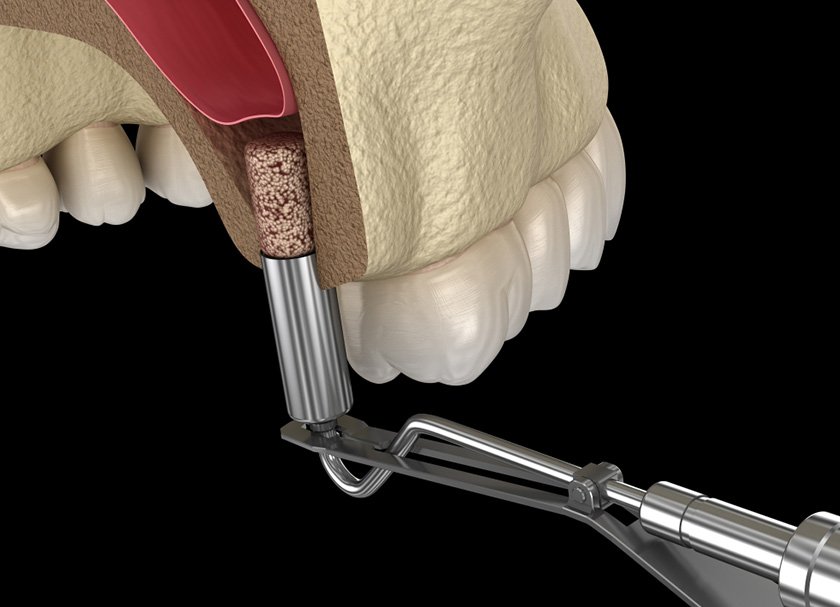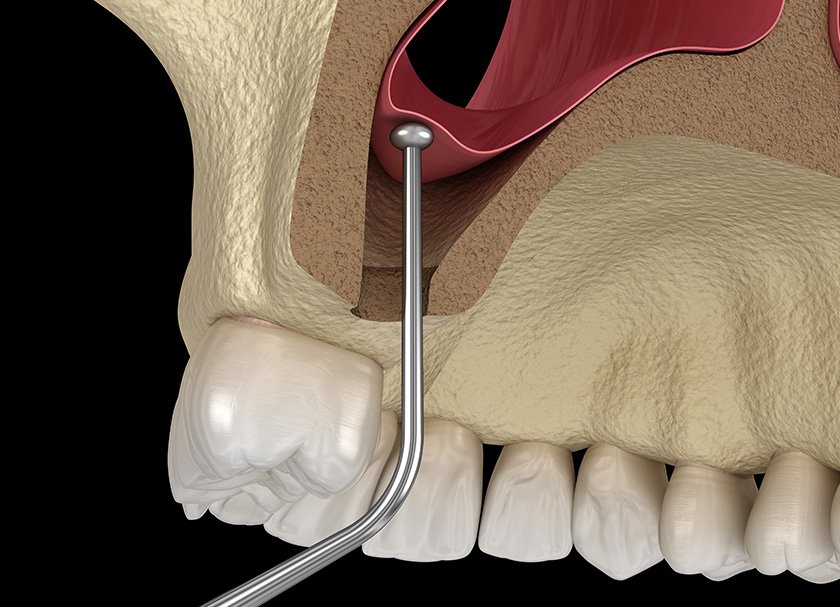Sinus Lift Treatment
A sinus lift surgery is an adjunct surgical procedure to the placement of dental implants. If dental implants are required in the upper jaw, but the volume or quality of bone is less, a sinus lift surgery can be planned along with the implant placement to improve the outcome and longevity of the implants placed.
A sinus augmentation or sinus transplant are other names for this procedure. This procedure is performed by an oral and maxillofacial surgeon.
At SmileMint Studio, Delhi, the oral surgeon will examine your oral health thoroughly and use a range of techniques for sinus lift surgery. Learn more about these techniques and how they may help maintain your dental implants in place by reading on.

Why Is Sinus Lift Surgery Required?
The maxillary sinus is augmented or raised during a sinus lift.
The rear of the maxilla, or upper jaw, has a series of air-filled chambers called the maxillary sinuses. A dentist can install an implant with additional bone by elevating the sinus and transplanting bone.
Lack of upper jaw bone prevents the implant from correctly anchoring and prevents your new dental implant from carrying out more demanding functions, including chewing.
The dental implant won’t be securely secured and might fail if there isn’t enough bone. You can have had jaw bone loss for a variety of causes, including:
- Early Extraction of molars and premolars
- Congenital disabilities
- Cancer
- Natural variation, such as having particularly wide nasal cavities or a thin jawbone, periodontal disease
The bones surrounding the teeth are often a case of use-it-or-lose-it. Your jawbone can gradually start to shrink out if you’ve lost teeth.
What happens Before Sinus Lift Treatment?
While it used to be considered a multi-stage procedure- with a sinus lift and bone grafting being an earlier step before the implant is placed, with the current cutting edge technology at SmileMint Studio, Delhi, a keyhole sinus lift, placement of bone graft and the dental implant is carried out in the same 30 minute visit. It is often advisable to wait for the bonegraft to heal before adding a tooth to the implant.
The procedure for getting dental implants typically proceeds as follows:
- You can discuss your expectations and your dentist’s recommendations for dental implants at the initial appointment.
- Your dentist may check your mouth, gums, and teeth
- Your dentist will perform imaging tests like X-rays or CBCT( a small CAT Scan of the jawbone) to determine the health and volume of your jawbone and other important skull components
- Your dentist may take impressions or scans of your upper and lower jaw to decide the best area for placement.
- A sinus lift surgery and bone grafting may be required. At SmileMint Studio, we conduct a digitally guided, minimally invasive sinus lift and bone graft, most often with immediate implant placement.
- Your dentist may place either a coverscrew or a healing abutment to cover the implant

Depending on your general dental health, the length of time that each phase of this process takes might vary.
Spending the time required to get the greatest outcomes is crucial because placing dental implants may be a highly expensive surge
Procedure
Sinus lift surgery can be done using a variety of methods. Depending on how much bone you presently have in your jaw, the sort of bone transplant the dentist is employing, and the prospective technique for placing dental implants later, the best course of action for you may vary.
The following are some of the key points in the procedure of a digital sinus lift:
- An oral surgeon will administer local anaesthesia with/without oral or inhalational sedatives or numb the affected region for comfort.
- A customised, prefabricated guide is placed on the upper jaw. This allows the surgeon to access the sinus through a key hole tissue punch
- There are no cuts or incisions placed, and stitches are not required.
- The bone is drilled through the keyhole to make space for the implant to be placed.
- The sinus membrane is raised through the implant osteotomy using gentle hydraulic pressure. This is done only in the region the implant is to be placed, thus making the procedure minimally invasive and leading to good, uneventful healing.
- A bone graft is placed through the keyhole to support the freshly elevated membrane
- An implant is placed within the fresh osteotomy and covered with a healing screw.
- The procedure generally takes a total of 30 minutes. However, sufficient time and care is spent before the procedure for proper scanning and planning of the implant.
Recovery
Pain, swelling and bleeding are a couple of the most typical adverse effects following a sinus lift. Normally, bleeding subsides within a couple of hours and the pain and swelling subside within 2-4 days. Avoid strenuous activity for the first couple of days, and these can be resumed as your doctor instructs.
The perforation of the sinus membrane is the most frequent complication to worry about during sinus lift surgery. This risk is offset by taking proper scans and measurements during the planning phase, following a digitally guided approach, and using only gentle hydraulic pressure to raise the membrane. By not using sharp instruments in the surgical area, the risk of membrane puncture, and subsequent risk of chronic sinusitis and sinus infection are minimised.
You can click here to see what instructions are recommended after a sinus lift.
Here are a few recommendations:
- If prescribed, use antibiotics to prevent infection.
- It would be best to avoid sneezing and strong nasal blowing as they may impact where the bone graft material is placed.
- Wait a set time before cleaning your teeth to prevent any clots or bleeding from being disturbed.
- To ease discomfort, use painkillers.
- Avoid drinking with a straw to avoid disturbing blood clots that stop bleeding.
- Avoid smoking, which leads to infection and delays healing. It may even lead to rejection of graft and or implant.
After the treatment, you will visit your doctor again in approximately a week. Call your doctor if you encounter bleeding that is challenging to control or discomfort that worsens rather than improves.
What to Expect?
It may take 3-6 months for the bonegraft to mature and implant to stabilise in your jawbone. Sometimes, when the bone is very low or of deficient quality, the implant is placed within the bone in a second step when the graft has matured sufficiently.
Schedule a Consultation
If you suffer any of the following sinus lift surgery:
Swells or hurts for two to three days then becomes worse
Pain or the perception that the bone graft components have migrated out of place after two to three days of bleeding (this could occur after vigorous sneezing or blowing your nose)
Infection symptoms including fever, edema, or odorous discharge from the surgery site
Reach out to us should you have more questions regarding the procedure.
FAQ's
A typical surgery lasts between an hour and two. Endoscopic sinus surgery is carried out through your nostrils and does not alter the outward contour of your nose or leave any facial scars. To inspect your nasal passageways, your surgeon will use a tiny telescope called an endoscope.
A sinus lift is generally uncomfortable but not always painful. A patient is unlikely to experience any pain during the operation, but afterward, they should anticipate some mild discomfort for a short while.
A sinus lift will usually improve the appearance of your face and reverse the sunken, prematurely aged appearance brought on by tooth loss by rebuilding bone lost in the upper jaw.
Reduce your physical activity as soon as possible after surgery. Please take it easy for the first few days and do as little as possible. You can start returning to your routine on the third postoperative day.
It Depends on the type of sutures used, they might dissolve in 10–14 days, or the surgical team might need to remove them.
1. How many hours are needed for sinus surgery?
A typical surgery lasts between an hour and two. Endoscopic sinus surgery is carried out through your nostrils and does not alter the outward contour of your nose or leave any facial scars. To inspect your nasal passageways, your surgeon will use a tiny telescope called an endoscope.
2. Does sinus lift painful?
A sinus lift is generally uncomfortable but not always painful. A patient is unlikely to experience any pain during the operation, but afterward, they should anticipate some mild discomfort for a short while.
3. How does the face look after a sinus lift?
A sinus lift will usually improve the appearance of your face and reverse the sunken, prematurely aged appearance brought on by tooth loss by rebuilding bone lost in the upper jaw.
4. Will I be able to walk after sinus lift surgery?
Reduce your physical activity as soon as possible after surgery. Please take it easy for the first few days and do as little as possible. You can start returning to your routine on the third postoperative day.
5. How long do stitches remain after a sinus lift?
It Depends on the type of sutures used, they might dissolve in 10–14 days, or the surgical team might need to remove them.
Regain Your Happy Smile in Healthy Way
Be it a dental checkup, an inquiry about a dental procedure, or correcting your dental issues, we assure quality care and a happy smile with flexibility in appointment scheduling.

